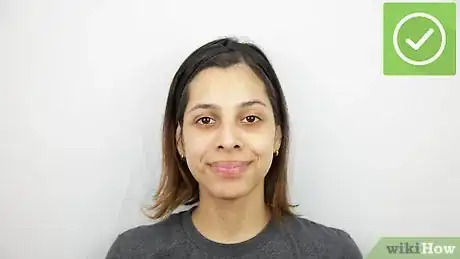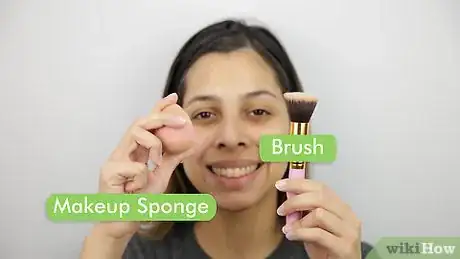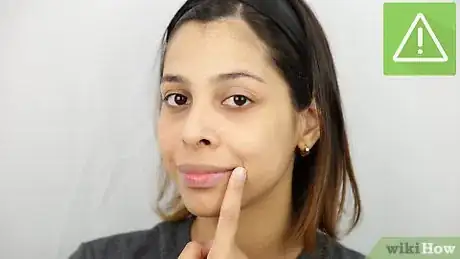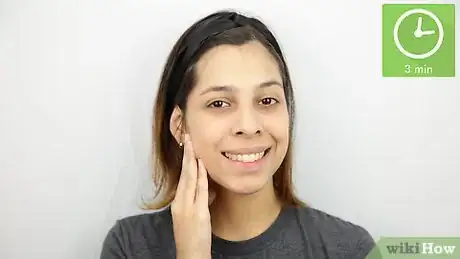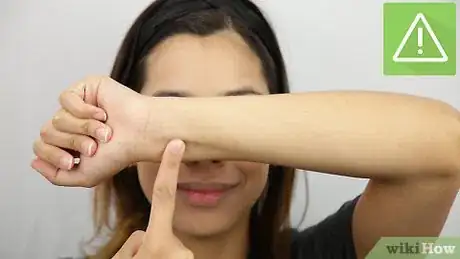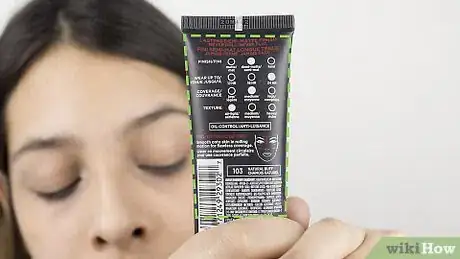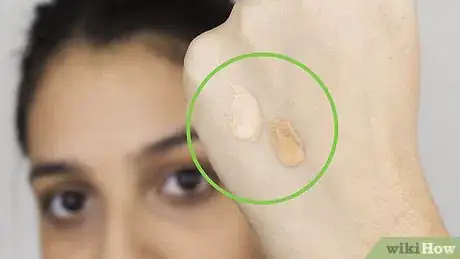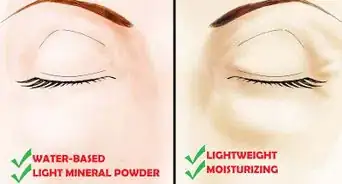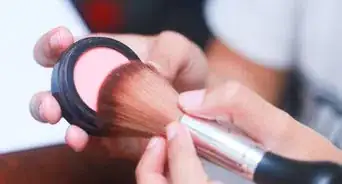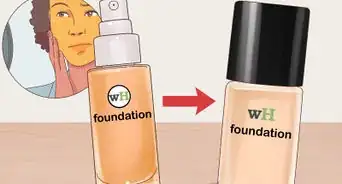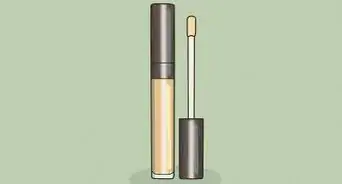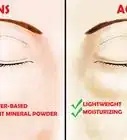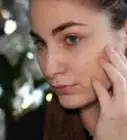This article was co-authored by Yuka Arora. Yuka Arora is a self-taught makeup artist who specializes in abstract eye art. She has been experimenting with makeup art for over 5 years, and has amassed over 5.6K Instagram followers in just 5 months. Her colorful and abstract looks have been noticed by Jeffree Star Cosmetics, Kat Von D Beauty, Sephora Collection, among others.
There are 15 references cited in this article, which can be found at the bottom of the page.
This article has been viewed 204,632 times.
Foundation is a type of cosmetic that’s used to cover discolorations and imperfections, minimize the appearance of pores, smooth out the skin’s texture, conceal blemishes, and provide a base for other cosmetics. Foundation is supposed to go on your skin to cover and conceal, but the makeup itself shouldn’t be noticeable or apparent. For foundation to look natural and even, you must apply it using the proper technique, but you also have to use the right foundation shade and type for your skin.
Steps
Applying Foundation Evenly
-
1Start with a clean, moisturized, and dry face. Wash your face with your favorite gentle cleanser. Apply the cleanser using circular motions, then rinse with clean water. Pat your face dry and apply a moisturizer.
- Allow the moisturizer to absorb into your skin fully before applying foundation, or it will be streaky and runny.[1]
-
2Choose the right tool. Liquid foundation should be applied with a brush, because a brush will use less foundation and blend the makeup better than your fingers or a sponge.[2] Apply cream foundations with a sponge.
- For liquid foundation, choose a synthetic brush with a dense and flat top.[3]
- If you have oily skin and want to use cream foundation, apply it with a damp sponge instead of a dry one.[4]
- It’s always better to use a brush or sponge to apply foundation, because your fingers can leave streaks, won’t rub the foundation in evenly, and can transfer dirt and bacteria to your face.[5]
Advertisement -
3Place a pea-sized dollop of foundation on your hand. Pour, pump, or scoop the foundation onto the back of your non-dominant hand so that you can easily access it with the brush.[6]
- To apply a thin layer of cream foundation evenly, mix it with a few drops of primer on the back of your hand. This will make for lighter coverage, and help the foundation spread and blend more easily.[7]
- You can add more foundation later if you find you need extra to cover all the essential spots.
- One of the keys to even foundation is using it sparingly, and only using foundation where it’s actually needed.[8]
-
4Dot the foundation around your face. Dip the application tool into the foundation and pick up about half the foundation that’s there.[9] Use the brush or sponge to dab a row of evenly spaced dots around the border of your face. Then put a few dots on each cheek, one or two on the chin, and one on your nose.[10]
- Use dabs that are evenly sized so that you'll have even foundation coverage.[11]
- Remember to concentrate on the areas that need the most coverage, which is usually the center of the face around the eyes and nose. If you need less around the outer edges of your face, only place a few dabs around the border.
-
5Blend the foundation evenly. Starting with your nose, start blending the foundation into your skin with the tip of the brush or sponge. Work in small areas to spread the foundation.
- When you're finished with the nose, move on to the cheeks, spreading and blending the dabs of foundation. Spread to cover the cheeks, but also focus on working the foundation inward toward the center of your face.
- After your cheeks, move on to the foundation around the border of your face, followed by the chin. Make sure you cover the areas you're working on, but also concentrate on spreading the foundation toward the center.[12]
-
6Apply the foundation to your eyes, mouth, and hairline. You may need to put some more foundation on your brush at this point. Dab small amounts of foundation around your mouth, under your eyes, and near your hair line.
- Spread and blend the foundation as before. Make sure you blend the new foundation seamlessly into the foundation that was already applied, and blend well around the hairline so you don’t leave a noticeable border.
- Make sure you only apply small amounts around your mouth, otherwise you may end up with noticeable foundation marks in the creases and smile lines.
-
7Put some foundation under your jawline. To ensure that there isn't a defined line of color between your face and neck, apply a small amount of foundation below your jaw and where your ears connect with your head.
- Blend the foundation under your jaw and around your ears inward and upward to connect it with the foundation on your face, as well as out and down to blend it into the skin on your neck.[13]
-
8Fill in any remaining areas. Use the remaining foundation on your hand to brush foundation to any areas that have been missed. Avoid adding more foundation to areas that have already been covered, or it will be thicker and unevenly applied in those spots.
- Only apply as much foundation as needed to cover the remaining areas, and blend well into the existing foundation on your face.
-
9Use only minimal foundation on fine wrinkles. Foundation can get into the fine lines and wrinkles on your face, and if this happens, it will leave creases that accentuate your wrinkles and make your foundation uneven.
- Apply smaller amounts of foundation in areas where you have more wrinkles or lines, and blend very well in these areas. You can also use a clean brush or sponge to remove excess foundation from these areas as you blend.[14]
Finishing the Look
-
1Buff and blend the foundation. Using the same brush or sponge that you used for application, go over your entire face to buff the foundation and even it out. Work the brush or sponge in small circles to remove excess, blend fully, and give the foundation a more natural skin texture.
- Go over your entire face two or three times like this, making sure to get under your eyes, under the jaw, and around the hairline as well.[15]
-
2Give the foundation time to set. Foundation needs about three minutes to dry and set properly. If you skip this step, you risk smudging the foundation and making it appear uneven in areas.[16]
- If necessary, buff certain areas again during this time, or blot excess foundation from areas using a tissue.
-
3Apply concealer. Concealer goes on after foundation to cover blemishes, redness, and dark spots. With your finger, dab on small amounts of concealer as needed, such as on your cheeks, on pimples, or under your eyes. Then use the same finger to gently massage and blend the concealer into your foundation.[17]
- To cover flaws properly, use a salmon concealer for blue or purple spots under the eyes, and use a green-tinted concealer for reddish blemishes. Avoid beige concealers or concealers that match the color of your skin tone.
-
4Finish with a setting powder. A setting powder will stick to your foundation and concealer and prevent it from smudging on your face, meaning your foundation will stay even and perfect all day. Setting powders also make great bases for other makeup.[18]
- Dip a large powder brush into your powder, and tap the brush to remove excess. Then apply the powder to your face using circular motions with the brush.
- With a smaller, denser brush, go over the powder on your face in a circular motion to blend the powder evenly and cover more fine lines.
- Setting and finishing powders are different, and setting powder usually goes on after foundation, then finishing powder goes on top.
Choosing the Right Foundation
-
1Know your undertone. Your undertone is the true color of your skin underneath sun tans, wind burns, acne and pimples, and redness and discoloration. It never changes, and it’s what you should use to determine what colors best complement you when it comes to things like clothes, makeup, hair, and jewelry. There are three different undertones that you could be, and they are:
- Cool: this means you have green, blue, or grey eyes paired with black, blond, or brown hair.[19] You will look best in silver jewelry, and you may turn red or burn easily in the sun.
- Warm: this means you probably have brown, amber, or hazel eyes paired with black, strawberry blond, or auburn hair. You look better in gold jewelry, and you tend to tan or bronze in the sun.[20]
- Neutral: you can have any combination of hair and eye color, you look good in both silver and gold jewelry, and you probably have bluish-green veins on your inner wrist.[21]
-
2Pick a foundation based on your undertone. While undertones can be cool, warm, or neutral, these designations actually refer to the true shade of your skin, meaning you'll have different complementary colors based on your undertone.[22]
- Cool: opt for tan, cocoa, sable, and fawn shades, and foundations with a blue or red base.
- Warm: try golden, chestnut, honey, and caramel shades, and foundations with a gold or yellow base.
- Neutral: you can wear them all, but look for something in the middle of pink and yellow, such as ivory, praline, or dark tan.
-
3Use foundation formulated for your skin type. Your skin type might be oily or dry, for instance, and the best foundation for you will be specifically formulated to manage that condition.[23] But no matter your skin type or what foundation you choose, always look for one that offers broad-spectrum protection from the sun.
- Oily skin: choose an oil-free or oil-absorbing foundation with a matte finish.
- Dry skin: look for a moisturizing cream foundation.
- Sensitive skin: try hypoallergenic foundations that are mineral-based and fragrance-free.
- Combination skin: go for a powder foundation.[24]
- Uneven complexion: choose a medium- or full-coverage foundation.
-
4Test foundation before using it. To ensure that a new foundation is the right shade and match for your skin, you should always test it out before wearing it. To test a new foundation:[25]
- On one side of your face, use a sponge or your finger to apply a small streak of foundation under your eye, around your nose, on your cheek, and on your jawline. Blend the foundation in to your skin slightly.
- In a mirror, compare the makeup-free and makeup sides of your face. Ideally, you want the foundation to disappear into your skin so that the foundation and non-foundation sides of your face still match.
- If the foundation is noticeable and doesn’t look natural, choose another shade.
- When necessary, go one shade darker than your actual skin rather than lighter, as this will provide better coverage for flaws and will look a little more natural than a shade that’s too light.
Expert Q&A
-
QuestionHow do I know if I need primer?
 Yuka AroraYuka Arora is a self-taught makeup artist who specializes in abstract eye art. She has been experimenting with makeup art for over 5 years, and has amassed over 5.6K Instagram followers in just 5 months. Her colorful and abstract looks have been noticed by Jeffree Star Cosmetics, Kat Von D Beauty, Sephora Collection, among others.
Yuka AroraYuka Arora is a self-taught makeup artist who specializes in abstract eye art. She has been experimenting with makeup art for over 5 years, and has amassed over 5.6K Instagram followers in just 5 months. Her colorful and abstract looks have been noticed by Jeffree Star Cosmetics, Kat Von D Beauty, Sephora Collection, among others.
Makeup Artist If you have any specific areas that are a different texture than the rest of your face — dry patches or areas with larger pores — a really good moisturizing primer can help smooth those out. If you have fairly even skin, then you can typically just use moisturizer, then foundation.
If you have any specific areas that are a different texture than the rest of your face — dry patches or areas with larger pores — a really good moisturizing primer can help smooth those out. If you have fairly even skin, then you can typically just use moisturizer, then foundation. -
QuestionWhat can be used instead of primer to blend foundation?
 Community AnswerCircular motions using a kabuki brush or dabbing on foundation with a sponge will ensure an even application.
Community AnswerCircular motions using a kabuki brush or dabbing on foundation with a sponge will ensure an even application. -
QuestionHow do I apply eyebrow makeup?
 Cecilia FloresTop AnswererHow you apply brow products really depends on what suits your face shape, how you like your brows to look and what brow product you use. Look up a bunch of videos and pictures on what brow shape is best for your face shape.
Cecilia FloresTop AnswererHow you apply brow products really depends on what suits your face shape, how you like your brows to look and what brow product you use. Look up a bunch of videos and pictures on what brow shape is best for your face shape.
References
- ↑ http://www.goodhousekeeping.com/beauty/makeup/tips/a32285/common-foundation-mistakes/
- ↑ http://beautyeditor.ca/2010/11/22/no-offense-but-youre-probably-making-one-of-these-7-mistakes-with-your-foundation
- ↑ http://www.makeupandbeautyblog.com/makeup-tipshow-to/how-to-apply-liquid-foundation/
- ↑ http://www.today.com/style/6-secrets-i-learned-makeup-artist-school-t74261
- ↑ http://www.goodhousekeeping.com/beauty/makeup/g2838/apply-foundation-with-brush-vs-hands/
- ↑ http://www.brit.co/should-you-apply-foundation-with-a-brush-or-your-fingers/
- ↑ http://www.today.com/style/6-secrets-i-learned-makeup-artist-school-t74261
- ↑ http://www.goodhousekeeping.com/beauty/makeup/tips/a32285/common-foundation-mistakes/
- ↑ http://www.makeupandbeautyblog.com/makeup-tipshow-to/how-to-apply-liquid-foundation/
- ↑ http://www.makeupandbeautyblog.com/makeup-tipshow-to/how-to-apply-liquid-foundation/
- ↑ http://stylecaster.com/beauty/how-apply-liquid-foundation-flawlessly/
- ↑ http://www.makeupandbeautyblog.com/makeup-tipshow-to/how-to-apply-liquid-foundation/
- ↑ http://www.makeupandbeautyblog.com/makeup-tipshow-to/how-to-apply-liquid-foundation/
- ↑ http://www.prevention.com/beauty/makeup-how/how-choose-and-apply-foundation
- ↑ http://stylecaster.com/beauty/how-apply-liquid-foundation-flawlessly/
- ↑ http://smitten-mag.com/cooking-your-makeup-how-to-set-your-foundation/
- ↑ http://www.today.com/style/6-secrets-i-learned-makeup-artist-school-t74261
- ↑ http://www.xovain.com/makeup/the-difference-between-finishing-powder-and-setting-powder
- ↑ http://www.bustle.com/articles/36375-warm-or-cool-skin-tone-5-questions-to-help-you-determine-your-undertones-so-you-can
- ↑ https://www.birchbox.com/magazine/article/how-to-match-makeup-undertone
- ↑ http://www.cosmopolitan.com/style-beauty/beauty/advice/g2414/best-foundation-for-your-skin-tone/?slide=2
- ↑ https://www.makeupgeek.com/content/articles/cool-vs-warm-whats-your-undertone/
- ↑ http://www.goodhousekeeping.com/beauty/makeup/tips/a32285/common-foundation-mistakes/
- ↑ http://www.oprah.com/style/How-to-Choose-and-Use-the-Right-Foundation
- ↑ http://beautyeditor.ca/2010/11/22/no-offense-but-youre-probably-making-one-of-these-7-mistakes-with-your-foundation
